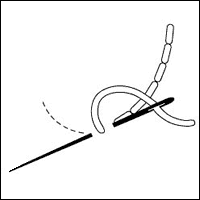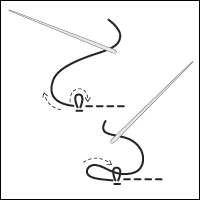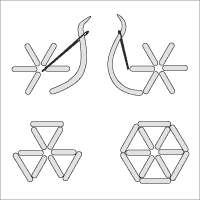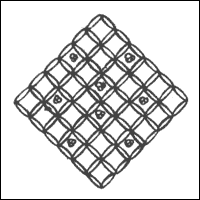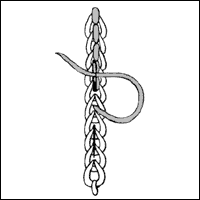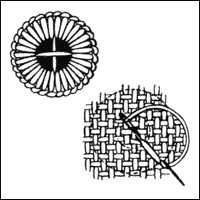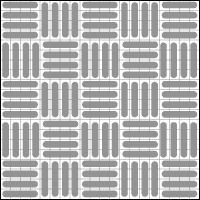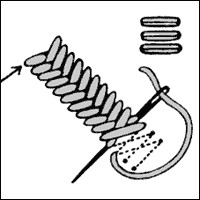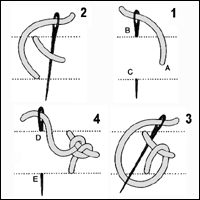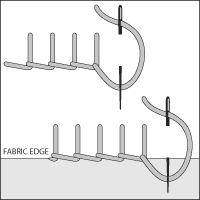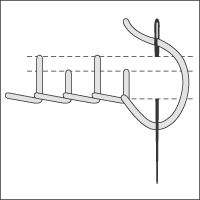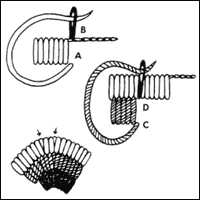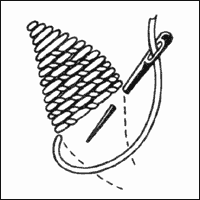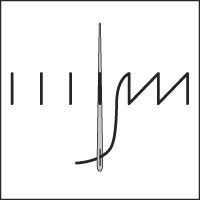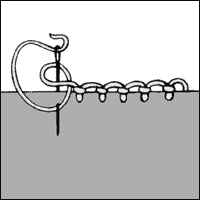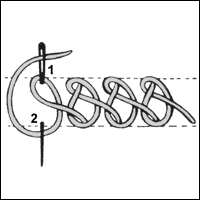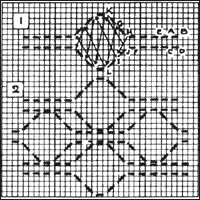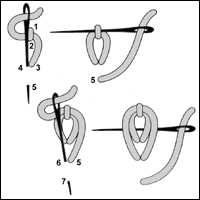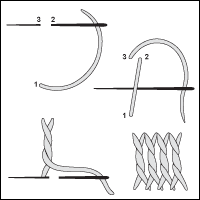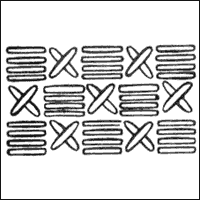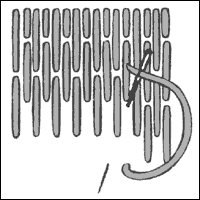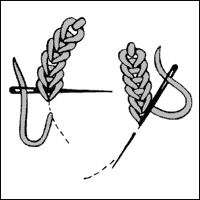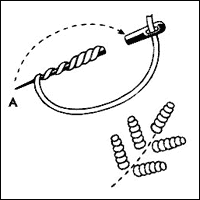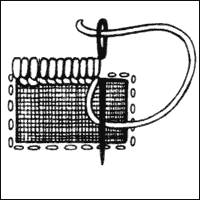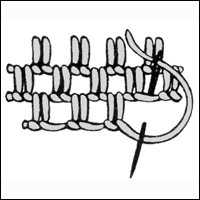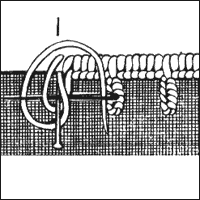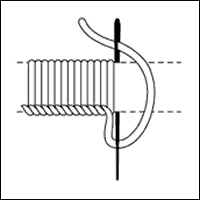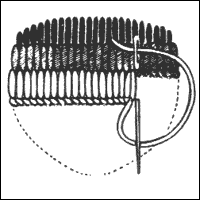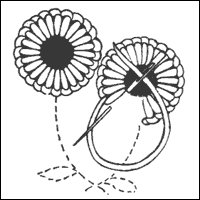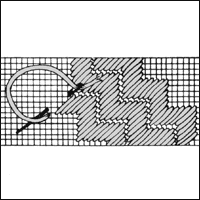Back Stitch
One of the most basic embroidery stitches. Worked from left to right. The needle is brought through from the back of the fabric a small distance from the starting point of the line to be covered. The needle is inserted at the beginning of the line, so the stitch is being created in the opposite direction of the actual line to be stitched. For the next stitch, the needle is brought through the fabric at a distance equal in length to the first stitch. The needle is then inserted in the same hole as the beginning of the stitch before it.
Point de Sable, Stitching
0 comments
Back Stitch Loop Knot
A hand-sewing knot used to end a stitched thread. When the last stitch has been completed, make a Back Stitch, approximately 1/8" behind the last stitch, bringing the needle back through the fabric to form a loop on top of the previous stitch. Pull the Back Stitch up so that the loop is on the top of the work. Put the needle through the loop and pull thread tightly. Trim the excess thread.
0 comments
Back Stitch Star
This stitch is actually a cluster of straight stitches. The foundation is similar to Star Stitch, but the rays are connected to form three triangles.
0 comments
Back Stitch Trellis
Used in Jacobean embroidery, a combination of Back Stitch and French Knots. Stitch all lines going in one direction, working back and forth from the end line to the beginning of the next. The lines going in the other direction will be stitched by the same method. May be worked diagonally to create diamonds, or horizontally to create squares. Small Cross Stitches may be used in place of the French Knots.
0 comments
Back Stitched Chain Stitch
A composite stitch in which Back Stitch worked down the center of a line of Chain Stitch. Using contrasting threads is most striking. Good for borders.
0 comments
Barred Buttonhole Wheel
A drawn fabric stitch. Buttonhole Stitch worked in a circular motif, but rather than each stitch entering the same center hole, the circle is worked in four segments with a circular center. The cross bars are created by leaving two perpendicular threads of the fabric free. The finished wheel is only about .25" across. Best suited for fabric with a somewhat open weave.
0 comments
Barrier Stitch
Worked the same way as Bosnian Stitch, except the angled stitches are joined from bottom to top of each vertical stitch.
Fence Stitch
0 comments
Basket Filling Stitch
A close, flat fill made up of alternating groups of three or four vertical and four horizontal satin stitches. Found in Jacobean embroidery.
0 comments
Basket Stitch
Similar in effect to Closed Herringbone. May be worked with more space between the stitches. Bring the needle up from the back of the fabric and insert it to the left and but slightly lower. Bring the needle up to the right and just below the beginning of the first stitch. Continue to end. Used to make a solid line or border.
0 comments
Blanket Stitch
One of the most basic embroidery stitches, with many variations. Worked from left to right.
Buttonhole Stitch, Spaced Buttonhole Stitch
0 comments
Blanket Stitch - Long & Short
A Blanket Stitch variation in which the verticals alternate in length.
0 comments
Blindstitch
A hand-sewing stitch used to attach the folded edge of an appliqué to the foundation fabric. Creates a nearly invisible stitch.
Appliqué Stitch, Slipstitch
0 comments
Bokhara Couching
A self-couching (continuous thread) stitch. Bokhara couching requires the use of a hoop or frame for proper stitching.
0 comments
Bosnian Stitch
Worked right to left along two parallel lines. When finished looks the same as Glove Stitch.
Bosnia Stitch
0 comments
Braid Edging Stitch
Worked right to left along a hem, with the edge of the fabric away from you.
0 comments
Breton Stitch
A stitch commonly found in the embroideries of Brittany. Similar in method to Closed Herringbone Stitch, with the stitches being twisted together. Best when worked in a hoop with heavy thread.
0 comments
Brick & Cross Filling
A composite fill method found in Jacobean embroidery.
Cross Stitch and Satin Filling
0 comments
Brick Stitch
Worked in back and forth rows: left to right, right to left and so on. The beginning row is made up of Long and Short Stitch, with additional rows being worked with uniform length Satin Stitches to form a brick pattern.
0 comments
Bullion Knot
One of the most common knots in embroidery. Often found in Brazillian and other raised embroideries. The thread is wrapped several times around the needle.
Bullion Stitch, Caterpillar Stitch, Coil Stitch, Grub Knot, Knot Stitch, Porto Rico Rose, Post Stitch, Worm Stitch
0 comments
Bullion Picot
A Bullion Knot stitched at the edge of the fabric, with the stitch starting and ending in the same needle hole. Used in Richelieu and Italian cutwork.
0 comments
Buttonhole Edging Stitch
Used in Cutwork, Richelieu and Renaissance Work, Italian Cutwork, Drawn Thread work, etc. The area to be cut away is outlined with Running Stitch and finished with Buttonhole Stitch. If the fabric frays easily, the shape is finished first and then the fabric cut away. Otherwise the area can be cut and the raw edge Buttonhole Stitched.
Buttonhole Stitch|77
0 comments
Buttonhole Filling
Not a detached filling as is Fancy Buttonhole Filling.
Spaced Buttonhole Filling
0 comments
Buttonhole Insertion Stitch
A simple insertion method. Groups of four Buttonhole Stitches are worked alternately on the edges of the fabrics to be joined.
0 comments
Buttonhole Stitch
Common. Buttonhole Stitch, as the name implies, was meant to reinforce the slash made to create the buttonhole. The same method of stitching as for Blanket Stitch, but the vertical threads are stitched close together.
Button Stitch
0 comments

